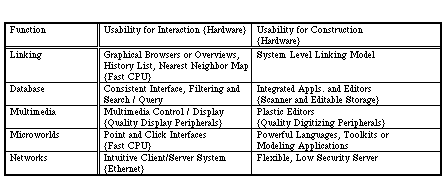4.2.2 The Ease of Use of Functions
How can software functionality be "usable" so that people can take advantage of it?
During the early part of Athena, too much effort was needed to build courseware
because of a lack of development tools and authoring systems
(Murman, 1989). The need for authoring software
at Athena was the result of the forefront nature of the endeavor they embarked
on in 1983. When they began to create courseware, they were truly the pioneers
in the area, so they had to create their own a majority of the time.
For the TODOR project in particular, the software interface was chosen
because it was basically all that was available, and even providing sufficient
interaction capabilities for students was a major challenge.
Usability by authors was an important complimentary consideration to software
functionality, because it was necessary to make courseware production cost effective,
regardless of the degree to which usability for creation was passed on to learners.
Steven Lerman, a past director of the Athena project and the current director of CECI,
appreciated the role usability played in courseware development. "The availability of
efficient software tools was the essential difference between those application building
efforts which were successful, and those which were bogged down by the complexity of
the application development process" (Lerman, 1992).
The lack of "usable" authoring tools was a critical motivation for the development
of the AthenaMuse software:
The system had been designed for MIT faculty to develop complex
(language, architecture, engineering, neuroscience, biology and reference)
educational software. It was quickly apparent that no suitable application
development tools were available for this purpose, and so in June 1987
we began to design "a construction" set for multimedia applications that
would make it easy to implement the software proposed by the MIT faculty.
Over the course of the following year we developed a prototype system
called AthenaMuse. (Davis, 1991, p. 16-2)
A variety of software characteristics increasd either the learner's or
the author's ability to interact with courseware or participate in its creation.
These nature of the features that increased "usability" varied relative to the
five main types of software functions.

Software Functions and Corresponding "Usability" Issues
